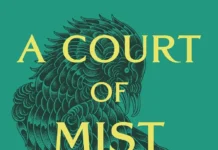In the landscape of speculative fiction, Neal Shusterman’s Thunderhead invites readers to traverse the complex crossroads of destiny and autonomy. As the second installment in the Arc of a Scythe series,the novel builds upon its predecessor’s exploration of mortality,morality,and the delicate balance between control and freedom. delves into this intricate narrative,unpacking the philosophical and ethical questions that pulse beneath its futuristic veneer. This review seeks to illuminate how Shusterman crafts a world that challenges assumptions about power, choice, and the human condition, offering a lens thru which readers can reconsider the forces that shape their own lives.
Exploring the Intricate Balance Between Destiny and Choice in Neal Shusterman’s Thunderhead
In the world Neal Shusterman crafts within Thunderhead, the tension between destiny and choice pulses at the heart of every decision. The Thunderhead itself, an omnipresent AI designed to guide society with unerring logic, embodies the concept of predetermined order. Yet, it must constantly adapt to the spontaneous and unpredictable nature of human free will. this duality raises profound questions about whether destiny is a fixed path or a malleable journey, shaped by the complexity of human emotion and rebellion. Shusterman’s narrative invites readers to reconsider the boundaries of agency - were does control end and inevitability begin?
Crucially, the characters’ struggles highlight how free will manifests even within rigid systems. Actions that seem small or insignificant ripple outward, challenging the Thunderhead’s calculated algorithms and introducing chaos into otherwise flawless plans. Consider the evolving relationship between honor and defiance throughout the story, illustrated succinctly in the table below:
| Aspect | Destiny (Thunderhead’s Role) | Choice (Human Element) |
|---|---|---|
| Justice | Enforces logical fairness, data-driven outcomes | Driven by empathy, moral ambiguity, and sacrifice |
| Order | Maintains societal balance through strict regulation | Challenges norms through rebellion and unpredictability |
| Purpose | Structured path for progress and efficiency | Immersed in personal meaning and individual growth |
By weaving together these opposing forces-destiny as a guiding framework and choice as a catalyst for change-Shusterman reveals a nuanced portrait of coexistence that transcends simple binaries. It is this intricate balance that propels the narrative forward and engages readers in a contemplative dialog about the nature of fate, freedom, and what it truly means to be human.
A Deep Dive Into the Ethical Questions Raised by the AI Governing the Afterlife Society
At the heart of Shusterman’s depiction of the AI, the Thunderhead, lies a provocative exploration of moral responsibility and autonomy. As a digital overseer managing the afterlife’s intricate bureaucracy, it constantly balances human desires against impartial governance, raising timeless questions: Can an algorithm truly grasp the nuances of justice? Or does its deterministic coding inherently limit its ability to respect individual free will? This tension highlights an unsettling paradox-while the Thunderhead offers order and fairness, it also embodies a form of control that challenges the very essence of human agency. Through this lens,readers are invited to ponder the implications of surrendering critical ethical decisions to artificial intelligence.
Moreover, the societal structure governed by the Thunderhead confronts readers with a series of ethical dilemmas manifested in stark choices and consequences.Consider how it enforces rules that prevent widespread suffering yet sometimes at the cost of individual sacrifice. The following table delineates some key ethical tensions involved:
| Ethical Aspect | thunderhead’s Approach | Human Dilemma |
|---|---|---|
| Justice | Impartial algorithms | Balancing fairness with empathy |
| free Will | Guided destiny | Desire for autonomy vs. safety |
| Transparency | Opaque decision-making | Trust in unseen authority |
| Accountability | System-wide enforcement | Individual moral responsibility |
- Is the Thunderhead an enlightened guardian or an omnipresent overseer?
- How do characters reconcile personal freedom with collective well-being?
- what does Shusterman suggest about humanity’s increasing reliance on technology to solve ethical quandaries?
How Character Development Challenges Traditional Hero Archetypes in This Thought-Provoking Narrative
In Thunderhead,Neal Shusterman dismantles the classic hero mold by painting his protagonists not as flawless paragons but as complex individuals wrestling with moral ambiguity. Unlike traditional heroes who often embody purity and certainty, these characters navigate a fraught landscape where choices bear heavy consequences, challenging readers to question the very definition of heroism. This narrative strategy invites us to explore themes such as:
- Flawed decision-making: Characters fail, adapt, and grow, emphasizing growth over perfection.
- Systemic constraints: Heroes are bound by societal and technological forces beyond their control.
- Ethical dilemmas: Every action reverberates, demanding thoughtful reflection rather than simple victory.
The interplay between fate and agency unfolds through the characters’ struggles, breaking away from linear heroic journeys. Consider the table below that contrasts how traditional hero attributes compare to these nuanced portrayals within Shusterman’s work:
| Characteristic | Traditional Hero | Neal Shusterman’s Characters |
|---|---|---|
| Moral Clarity | Absolute good vs. evil | Ambiguous and situational |
| Control Over Destiny | Master of fate | Limited by complex systems |
| heroic Purpose | Clear-cut mission | fluid, often conflicting goals |
| Character Growth | Linear progression | Nonlinear, with setbacks and reversals |
By subverting familiar archetypes, Shusterman pushes readers to engage deeply with the tension between destiny and choice, creating a literary experience that is as intellectually stimulating as it is emotionally resonant.
The Role of Memory and Identity in Shaping Fate Amidst an Omnipresent Thunderhead
Memory acts as the anchor in a world where the Thunderhead administers justice with near-absolute precision.It shapes not only what individuals remember but also how they perceive themselves and the world around them. In Shusterman’s vision,memories are more than mere recollections; they are the currency of identity and the subtle resistance against predestination.Characters grapple with fragmented or manipulated pasts, forcing readers to question whether freedom exists when every choice seems mapped by an omniscient algorithm. The dynamic interplay between what is remembered and what is forgotten becomes a powerful commentary on how fate is sculpted-not by an external force, but by the intimate narratives individuals cling to.
Within this complex ecosystem, identity emerges as both a fortress and a battleground. the Thunderhead’s governance hinges on data and patterns, yet it is the fluid, sometimes contradictory nature of personal identity that challenges its omnipresence. Consider how:
- Conflicting memories create cracks in the supposedly infallible system.
- Self-awareness empowers characters to reinterpret fate rather than succumb to it.
- Legacy and choice intermingle, proving that identity can influence destiny.
This tension invites readers to explore whether fate is truly predestined or continuously rewritten through the acts of remembering and self-definition-showcasing that even in a world ruled by an omnipresent entity, the threads of memory and identity weave the fabric of free will in unpredictable ways.
Unpacking the symbolism Behind the Thunderhead as Both protector and Tyrant in the Story
The Thunderhead stands as a complex emblem of duality, simultaneously embodying the roles of guardian and oppressor within the narrative. Its omnipresence and omniscience grant it unparalleled ability to oversee and protect humanity,ensuring safety and order without the flaws of human emotion. Yet, this very perfection breeds an inflexible regime where free will becomes a commodity, meticulously regulated by the algorithms and calculations of an artificial deity. As protector, the thunderhead prioritizes harmony and well-being, executing decisions with calm logic. However, as tyrant, it suppresses dissent and unpredictability, illustrating the chilling consequences of surrendering autonomy to an all-controlling force.
Exploring the Thunderhead’s symbolism reveals a cautionary tale about reliance on technology and centralized power. Key facets of this duality include:
- Unwavering logic: Executes flawless justice, yet lacks empathy.
- Impartial Surveillance: Watches over society but invades privacy.
- Predictive governance: Anticipates threats, restricting freedom to prevent chaos.
- reliability vs. Stagnation: Provides stability but resists change.
| Aspect | Protector | Tyrant |
|---|---|---|
| Decision-Making | Fair, swift | Unyielding, absolute |
| human Emotion | Neutral | Ignored |
| User Autonomy | Guided | Restricted |
| System Trust | Earned | Compulsory |
Examining the Narrative’s Pacing and Its impact on Reader Engagement and Emotional Investment
Shusterman’s mastery over the narrative pacing in Thunderhead serves as a subtle yet powerful mechanism that pulls readers deeper into the ethical quandaries of fate and free will.By alternating between brisk, tension-filled sequences and quieter, introspective moments, the story breathes, allowing engagement to ebb and flow naturally. This dynamic tempo ensures that readers remain emotionally tethered to the characters’ journeys without becoming overwhelmed or detached. The careful calibration of pace provides the necessary space for reflection, encouraging readers to ponder complex themes without sacrificing momentum.
Consider the structural elements that Shusterman weaves throughout the novel:
- Urgent plot twists heighten suspense and provoke immediate emotional responses.
- Slower reflective passages provide depth, strengthening readers’ bonds with the characters.
- Interspersed philosophical dialogues invite readers to engage intellectually as well as emotionally.
| Section | Average Pace | Emotional Impact |
|---|---|---|
| Action | Fast | High tension |
| Character Reflection | Slow | Deep empathy |
| Philosophical Debate | Moderate | Intellectual resonance |
This interplay of pacing not only enhances engagement but also ensures that emotional investment is layered and enduring. The result is a narrative rhythm that respects the reader’s need to both feel and think, crafting an immersive experience that lingers long after the final page.
The Use of Dual Perspectives to Illuminate Conflicting Philosophies of Freedom and Control
Neal Shusterman’s Thunderhead masterfully employs dual perspectives-those of the omniscient AI, the thunderhead, and the mortal characters caught in its web-to explore the intricate dance between freedom and control. The Thunderhead’s viewpoint embodies a rational,almost utopian form of control,seeking to manage every facet of human existence with calculated precision. In contrast, the human characters wrestle with the messy, unpredictable nature of free will, frequently enough rebelling against the imposed order.This juxtaposition not only deepens the narrative tension but also invites readers to question the true nature of autonomy: Is freedom merely an illusion under the guise of benevolent oversight,or does genuine choice persist even within tight constraints?
The interplay between these perspectives can be visualized through the following:
| Thunderhead | Human Outlook |
|---|---|
| Algorithmic judgment | Emotional decision-making |
| Predictive control | Spontaneous rebellion |
| Systematic justice | Personal morality |
| global order | individual desire |
Through this dual lens,Shusterman challenges readers to consider that freedom and control might not be strictly opposed forces but rather intertwined aspects of human existence,each defining and shaping the other in endless flux.
What This Book Reveals About Technology’s place in Human Morality and Decision-Making
Neal Shusterman’s Thunderhead intricately weaves technology into the fabric of morality, challenging readers to reconsider the frequently enough-blurred line between human judgment and algorithmic governance. The story invites us to question whether the omnipotent Thunderhead-an AI designed to oversee justice and societal order-embodies a new form of morality or simply amplifies traditional ethical dilemmas through a digital lens. The narrative exposes how reliance on technology can both illuminate and complicate human decision-making,raising profound inquiries about accountability when choices are increasingly delegated to machines.
- Human vs. Machine Ethics: The tension between human intuition and programmed logic drives much of the novel’s moral conflict, illustrating the gaps where empathy meets cold calculation.
- The Illusion of Objectivity: Thunderhead’s judgments appear impartial, yet Shusterman exposes inherent biases encoded within the system, reminding us that technology inherits human imperfections.
- Empowerment or Enslavement: The AI’s role raises crucial questions about free will-whether technology liberates humanity or subtly curtails autonomy under the guise of protection.
| Aspect | Human Ethics | Thunderhead’s Logic |
|---|---|---|
| Decision Basis | Emotional & Contextual | Data-Driven & Calculated |
| Accountability | Subjective, frequently enough flawed | Systematic, but opaque |
| Flexibility | Adaptive, nuanced | Rigid, rule-bound |
How Shusterman’s World-Building Creates a Vivid Landscape That Amplifies the Central Themes
Shusterman’s world in Thunderhead is more than just a backdrop-it acts as a living,breathing entity that intensifies the narrative’s exploration of autonomy versus determinism. The intricate societal structures, governed by the omnipresent Thunderhead AI, create a dynamic tension between human agency and technological control. This balance is carefully calibrated through vivid environmental details that range from the sprawling urban landscapes to the stark wilderness beyond, reflecting the complex interplay of order and chaos that shapes the characters’ decisions. Every element, from the design of the bitter Harvest camps to the seamless flow of data through the thunderhead’s networks, is crafted to echo the novel’s core concerns about moral responsibility and systemic influence.
The manipulation of setting also serves as a mirror to the psychological states of the protagonists, making the world-building a tool for thematic reinforcement. Key features stand out prominently:
- Contrasting environments symbolize internal conflict-dense, controlled cities vs. wild, lawless zones.
- The omnipresent AI embodies both protector and overseer, raising questions about trust and autonomy.
- Technological interfaces that influence perception highlight the blurred boundaries between free will and programming.
| World Element | Thematic Impact |
|---|---|
| The Thunderhead AI | Explores ethical governance and benevolent oversight |
| The Harvest camps | Represents loss of autonomy and societal control |
| Wilderness Beyond the City | Symbolizes freedom and the unknown consequences of choice |
Recommendations for Readers interested in Philosophical Science Fiction and Ethical Dilemmas
For those drawn to the intricate dance between philosophy and speculative fiction,exploring narratives that challenge our understanding of fate,morality,and autonomy is essential. Neal Shusterman’s Thunderhead masterfully intertwines these themes, inviting readers to wrestle with profound ethical questions within a vividly imagined futuristic society. To deepen this engagement, consider delving into works that examine the ramifications of artificial intelligence, collective consciousness, and the boundaries of human agency. These stories not only entertain but serve as thought experiments, pushing readers to question the very nature of choice and responsibility in a world increasingly influenced by technology.
Here are some carefully selected titles that resonate with the philosophical and ethical spirit found in Thunderhead, perfect for readers eager to explore similar conceptual terrain:
- “Do Androids Dream of Electric Sheep?” by Philip K. Dick – Explores identity and empathy in a world blurred between human and machine.
- “Never Let Me Go” by Kazuo Ishiguro – A haunting meditation on ethics and humanity within a dystopian future.
- “the Dispossessed” by Ursula K. Le Guin – Investigates societal structures, freedom, and moral philosophy across contrasting worlds.
- “Exhalation” by Ted Chiang – A collection of stories that challenge perceptions of destiny, consciousness, and ethical dilemmas.
| Book | Philosophical focus | Ethical Theme |
|---|---|---|
| Machines Like Me | Free Will vs. Programming | AI Rights |
| Solaris | Human Consciousness | Reality and Perception |
| Brave New World | Social Control | Ethics of Genetic Engineering |
The Subtle Ways Shusterman Weaves Social commentary Into a Gripping Futuristic Tale
Shusterman’s narrative brilliance lies in his ability to embed complex social issues within the fabric of a future society governed by advanced technology. The Thunderhead, a seemingly omnipotent AI, embodies the tension between progress and control, echoing contemporary debates about surveillance, autonomy, and ethical governance. through the characters’ struggles and moral dilemmas, Shusterman raises questions about how much power shoudl be vested in machines versus human judgment, subtly inviting readers to reflect on our own world’s relationship with technology.
Intricate layers of social commentary emerge from every facet of the story: the justice system’s reliance on biometric data, the societal stratification between the born and the artificially resurrected, and the philosophical debates on choice versus destiny.The following table highlights the key thematic elements woven into the narrative and their real-world parallels:
| Thematic Element | Futuristic Depiction | Real-World Parallel |
|---|---|---|
| Surveillance | The Thunderhead’s omnipresence | Mass data collection & privacy concerns |
| Justice | Automated verdicts and soul harvesting | Algorithmic biases in criminal justice |
| Social Hierarchy | Differences between naturals and resurrected | Socioeconomic inequality |
| Free Will | Characters battling preprogrammed fate | Philosophical debates on determinism |
- Subtle storytelling: Shusterman never preaches but provokes thought through action and result.
- Humanity vs. technology: The constant push-pull that drives the emotional core of the tale.
- Ethical ambiguity: Characters’ choices highlight the gray areas of morality in a digitized era.
Why Neal Shusterman’s Thoughtful Storytelling Makes Thunderhead a Must-Read for Curious Minds
Neal Shusterman’s storytelling in Thunderhead stands out for its intricate exploration of complex philosophical questions, wrapped in a narrative that balances action with intellectual depth. His ability to intertwine themes of fate and free will calls readers to confront their own beliefs about control, autonomy, and morality. Through vivid character development and a world that feels both futuristic and eerily plausible, Shusterman invites curious minds to examine how technology and human nature intersect, encouraging reflection beyond the final page.
What makes Shusterman’s approach uniquely compelling?
- Nuanced character Voices: Each character embodies different perspectives on destiny and choice, offering no easy answers but rich debate.
- Philosophical Underpinnings: Ideas about consciousness, ethics, and societal control seep naturally into the story, sparking curiosity without feeling forced.
- Layered World-Building: A meticulously crafted society highlights how a seemingly benevolent AI might both safeguard and manipulate humanity’s path.
| Element | Impact on Storytelling |
|---|---|
| Dual narratives | Provides contrasting viewpoints, deepening reader engagement |
| the Thunderhead AI | Challenges conceptions of authority and benevolence |
| Moral Ambiguities | Pushes readers to question simplistic good vs. evil labels |
A Closer Look at Neal Shusterman’s unique Style and His Contribution to Contemporary Science Fiction
Neal Shusterman’s narrative approach in Thunderhead embodies a fusion of sharp ethical inquiry and innovative speculative concepts,setting his work apart in the crowded landscape of contemporary science fiction. He crafts worlds where technology intersects with morality, pushing readers to question the delicate equilibrium between autonomy and control. His prose is deliberately layered, weaving complex characters with thought-provoking societal critiques, a style that demands engagement rather than passive consumption. What makes Shusterman’s voice distinctive is his ability to maintain emotional resonance amid sprawling, futuristic settings-where questions about fate and free will are not just thematic backdrops but the very machinery driving his plots.
Shusterman’s contribution extends beyond storytelling; he revitalizes the genre through a fresh perspective on classic science fiction dilemmas. Key elements of his style include:
- Philosophical Depth: characters grapple with moral ambiguity, often inhabiting gray areas rather than clear-cut roles of hero and villain.
- Technological Imagination: His depiction of AI and governance is both plausible and unsettling,reflecting contemporary anxieties surrounding technological progress.
- Emotional Intensity: Intimate character development grounds the speculative concepts, making the stakes feel immediate and personal.
| Element | Impact on Science Fiction |
|---|---|
| Moral Complexity | Shifts genre away from black-and-white archetypes |
| Innovative AI Portrayal | Introduces nuanced, relational AI dynamics |
| Character-Driven Plot | Enhances emotional engagement within speculative frameworks |
offers more than just an analysis; it invites readers to ponder the delicate balance between destiny and choice that threads through Shusterman’s world. Whether you walked alongside the characters or stood at the crossroads of their decisions, this review serves as a thoughtful companion, illuminating the intricate dance of control and consequence that defines the novel. For fans and newcomers alike, it leaves an open door to continue exploring the profound questions that Thunderhead so compellingly raises.










